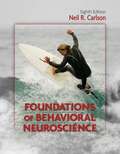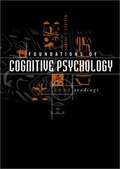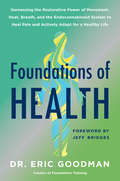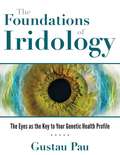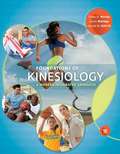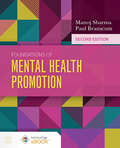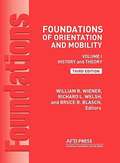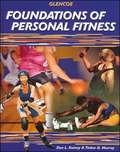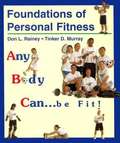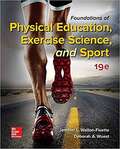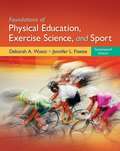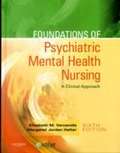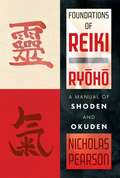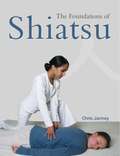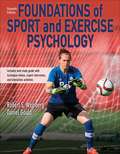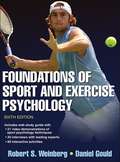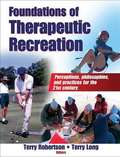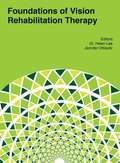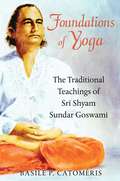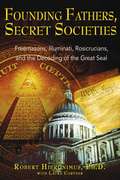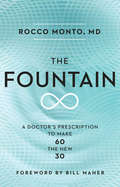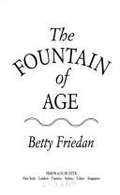- Table View
- List View
Foundations of Behavioral Neuroscience (Eighth Edition)
by Neil R. Carlson'Foundations of Behavioral Neuroscience' offers a briefer, sixteen chapter introduction to the foundations of physiology, incorporating the latest studies and research in the rapidly changing fields of neuroscience and physiological psychology.
Foundations of Cognitive Psychology: Core Readings
by Daniel J. LevitinScientists from many disciplines, including physics, chemistry, biology, and neuroscience, contribute to the study of cognition. Cognitive psychology, the science of the human mind and of how people process information, is at the core of empirical investigations into the nature of mind and thought. This anthology is based on the assumption that cognitive psychology is at heart empirical philosophy. Many of the core questions about thought, language, perception, memory, and knowledge of other people's minds were for centuries the domain of philosophy. The book begins with the philosophical foundations of inquiry into the nature of mind and thought, in particular the writings of Descartes, and then covers the principal topics of cognitive psychology including memory, attention, and decision making. The book organizes a daunting amount of information, underlining the essentials, while also introducing readers to the ambiguities and controversies of research. It is arranged thematically and includes many topics not typically taught in cognition courses, including human factors and ergonomics, evolutionary psychology, music cognition, and experimental design. The contributors include Daniel Dennett, Daniel Kahneman, Jay McClelland, Donald Norman, Michael Posner, Stephen Palmer, Eleanor Rosch, John Searle, Roger Shepard, and Anne Treisman.
Foundations of Epidemiology
by Marit L. BovbjergUnderstanding human health-defined by the World Health Organization (WHO) as a “state of complete physical, mental, and social well-being, and not merely the absence of disease or infirmity”i —is vital. Why are these people sick but those people aren’t? What can we do to improve health for everyone? Improved health in turn leads to gains in economic, social, educational, and other arenas, all of which are necessary for a successful, functioning society. Unfortunately, to understand human health, we must study humans—and humans are extremely difficult to study. Unlike laboratory-based sciences, where all conditions are under the control of the scientist, conducting scientific studies with human participants includes a host of complications and potential stumbling blocks. First and foremost, humans do not exist in controlled settings like laboratories. Each person has their own job, their own preferred foods, their own sleep schedule, their own hobbies, their own genetics, their own stress levels, their own set of environmental and social settings—all of which affect health. Since no two people are exactly alike, and since we cannot really tell people what to do, studying them is difficult.
Foundations of Health: Harnessing the Restorative Power of Movement, Heat, Breath, and the Endocannabinoid System to Heal Pain and Actively Adapt for a Healthy Life
by Eric GoodmanThe Founder of the proven Foundation Training program takes his teaching to the next phase, showing us how to utilize our body’s built-in systems for healing and introducing a new program that offers a perpetual inner core of wellness and adaptability.Dr. Eric Goodman’s innovative approach to self-healing—Foundation Training—has helped athletes, first responders, celebrities, and regular folks around the world. The heart of Foundation Training is a unique form of biomechanics—a series of postures, poses, and movements designed to teach the body’s individual muscles to act within strong, flexible chains, shifting the burden of support away from sensitive joints.Foundations of Health builds on this core program, going deep into its principles to help us understand how to maintain a healthy body, even when the mechanics eventually break down. Our bodies are built to heal themselves—without surgeries and prescriptive medications. The protocols expand on the original Foundation Training concepts, focusing on the endogenous cannabinoid stimulators—part of an extraordinary built-in endocannabinoid system that profoundly affects our central, enteric, and peripheral nervous systems and helps to regulate numerous responses in our body.Dr. Goodman explains the science behind the endogenous cannabinoid system and how it can be stimulated in natural and healthy ways, including heat, breath work, and movement—techniques that will help guide and maintain the state of balance the body needs to function optimally with stability and harmony. He recommends foods, herbs, and supplements likely to ease pain, lower stress, and boost mental and physical function. He addresses the notable medicinal benefits of CBD, THC, and the many terpenes associated with cannabis’s reputation for healing, and teaches how to be a smart consumer of cannabinoids.Foundations of Health provides a unique understanding and approach to healing that will forever change the way we think of our bodies and our physical health.
The Foundations of Iridology: The Eyes as the Key to Your Genetic Health Profile
by Gustau PauA complete guide to decoding the iris to reveal health predispositions for prevention and early treatment • Details the fundamental reflex signs of iridology and how to identify constitutional strengths and weaknesses in the stroma, pigments, and capillaries of the eyes as well as read energy patterns in pupil tone • Explores the history and development of iridology from the 18th century to today • Includes analysis of real case studies with full-color photos and illustrations The iris of your eye is a personal and unique identifier that expresses much more about us than we can imagine. Through detailed observation of the irises’ stroma, pigments, and capillaries, you can determine a person’s constitutional strengths and weaknesses and gain insight into their genetic predisposition to certain illnesses as well as preventive and treatment options that would be most effective. By reading the iris, practitioners of natural medicine can interpret the signs that reveal a client’s lifestyle choices and use this knowledge to make enlightened decisions regarding the client’s health plan and how to help them realize their full potential. In this full-color guide, Gustau Pau, an iridologist with more than 35 years of experience, details the chromatic scale and signs expressed in the eyes and how to use them to identify organs and their function as well as susceptibility to specific ailments. He explores the history and development of iridology from Hildegard von Bingen’s work on healing to 18th-century European scientists, including Ignaz von Peczely, the father of modern iridology. He reveals recent iridology developments on identifying genetically inherited physical traits, explaining how individuals can use this insight to make nutritional and lifestyle choices that will offset inherited weaknesses and bolster strengths. Focusing on the digestive system, he shows how the pupillary zone can reveal digestive function and demonstrates how diet is responsible for causing many diseases. The author also explores miasmas in the eyes, includes methods for reading energy patterns in pupil tone, and offers the scientific explanation for the old contention that the “eyes are the windows of the soul.” Illustrating the fundamental signs that iridologists use for reference, Pau provides sample iridographies and real case studies with photos and diagrams. Explaining how scientific research on the eye has not yet caught up with the innovations of iridology, he shows how the eyes reveal both our internal state and future health and have a much broader role in the body that we are only now just discovering.
Foundations of Kinesiology: Studying Human Movement and Health (Second Edition)
by Peter KlavoraFOUNDATIONS OF KINESIOLOGY (2nd ed.) is a textbook designed for senior high school and introductory college and university programs in kinesiology, physical education, and exercise science. The book explores the multifaceted world of kinesiology: the study of human movement and the body s response to exercise. It examines the systems, factors, and principles involved in human development within the context of society. Relevant fields in the study of kinesiology include anatomy, physiology, biomechanics, nutrition, motor learning and control, and sport psychology, sociology, and philosophy. The relevant career options available to students in the field are also examined.
Foundations of Kinesiology: A Modern Integrated Approach
by Tinker D. Murray James A. Eldridge Harold W. KohlFoundations of Kinesiology: A Modern Integrated Approach helps you to explore your career options and sharpen your professional skills. The text focuses on physical activity as the center of the Kinesiology universe. It emphasizes the evolving and ever-changing career opportunities available working with individuals and populations across the lifespan--children, adolescents, adults and older adults--and in a variety of settings, including work, leisure, transportation, home, schools, sport, fitness facilities and rehabilitation centers. It equips you with a solid foundation in basic Kinesiology and helps you develop the skills you need for a career in personal training, occupational and physical therapy, athletic training, sports psychology or sports management.
Foundations of Mental Health Promotion
by Manoj Sharma Paul BranscumWritten for undergraduate and graduate courses in public and community health, the second edition of Foundations of Mental Health Promotion provides a current look at mental health and mental illness with a focus on medical, epidemiological, behavioral, sociological, political, historical, developmental, and cultural perspectives in the field. Readers are introduced to the field of mental health promotion, and both individual-level and population-level approaches to handling mental health concerns are emphasized.
Foundations Of Orientation And Mobility: Volume 1: History And Theory
by William Wiener Richard Welsh Bruce BlaschFoundations of Orientation and Mobility, the classic professional reference and textbook has been completely revised and expanded to two volumes by the most knowledgeable experts in the field. The new third edition includes both the latest research in O&M and expanded information on practice and teaching strategies. Volume 1, History and Theory, includes the bases of O&M knowledge, including perception, orientation, low vision, audition, kinesiology, psychosocial issues, and learning theories, as well as chapters on technology, dog guides, orientation aids, and environmental accessibility. A section on the profession of O&M includes its international history; administration, assessment and program planning; and a chapter on research in O&M. No O&M student or professional can afford to be without this essential resource.
Foundations of Personal Fitness
by Don L. Rainey Tinker D. MurrayEach Active Mind--Active Body feature provides an opportunity that lets you investigate an important concept for improving your fitness. Follow the steps under What Will Do to get started and summarize your experience in Apply and Conclude.
Foundations of Personal Fitness: Any Body Can... Be Fit!
by Don L. Rainey Tinker D. MurrayThe book discusses the foundations of physical fitness, the benefits of regular exercise, and the advantages of weight training and proper nutrition.
Foundations of Physical Education, Exercise Science, and Sport
by Jennifer L. Walton-Fisette Deborah A. WuestThe Nineteenth Edition of Foundations of Physical Education, Exercise Science, and Sport emphasizes the role of culturally competent professionals in meeting the needs of our increasingly diverse population and in promoting lifespan participation in physical activity for all people. Up-to-date statistics and information are provided on health and physical activity levels, career preparation and professional paths within physical education, exercise science, and sport. <p><p>This edition retains its strong coverage of the foundations of motor behavior, biomechanics, exercise physiology, sport and exercise psychology, the sociology of sport, and physical education pedagogy. The text also emphasizes preparation for a diversity of careers in a variety of settings, addressing areas that include teaching, coaching, exercise leadership, athletic and personal training, sport management, and sport media.
Foundations of Physical Education, Exercise Science, and Sport 17th Edition
by Deborah A. Wuest Jennifer FisetteIntegrating the traditional presentation of the nature, scope, philosophy, and history of physical education and sport with the growing career opportunities available within this dynamic field, this text addresses the challenges and the future of the discipline. It emphasizes preparation for a diversity of careers, addressing areas such as teaching, coaching, exercise leadership, athletic and personal training, sport management, and sport media.
Foundations of Psychiatric Mental Health Nursing: A Clinical Approach (6th Edition)
by Elizabeth M. Varcarolis Margaret Jordan HalterThe 6th edition of this textbook offers a clear, straightforward way to understand the often intimidating subject of psychiatric mental health nursing. Its practical, clinical perspective and user-friendly writing style help you quickly master key concepts. Clinical chapters follow the nursing process framework and progress from theory to application with a wealth of real-world examples to prepare you for practice.
Foundations of Psychiatric Sleep Medicine
by John W. Winkelman David T. PlanteSleep-related complaints are extremely common across the spectrum of psychiatric illness. Accurate diagnosis and management of sleep disturbances requires an understanding of the neurobiological mechanisms underlying sleep and wakefulness, the characteristics of sleep disturbance inherent to psychiatric illness and primary sleep disorders, as well as the psychopharmacologic and behavioral treatments available. Foundations of Psychiatric Sleep Medicine provides a uniquely accessible, practical, and expert summary of current clinical concepts at the sleep-psychiatry interface. Topics covered include: basic principles in sleep science, clinical sleep history taking, primary sleep disorders in psychiatric contexts, and sleep disturbance across a range of mood, anxiety, psychotic, substance use, cognitive and developmental disorders. Written by outstanding experts in the field of sleep medicine and psychiatry, this academically rigorous and clinically useful text is an essential resource for psychiatrists, psychologists and other health professionals interested in the relationship between sleep and mental illness.
Foundations of Reiki Ryoho: A Manual of Shoden and Okuden
by Nicholas PearsonA comprehensive guide to the first and second degrees of Usui Reiki Ryoho as well as Reiki’s history and Western evolution • Details hand positions, self-healing exercises, spiritual development meditations, and the Japanese Reiki techniques introduced in the first degree, shoden, and the second degree, okuden • Provides a thorough introduction to the five levels of byosen, the energetic mechanism used to scan an individual’s energy field and locate areas of disharmony • Examines the core teachings of Reiki founder Usui Mikao and offers a new comprehensive exploration of Reiki’s history and evolution • Explores tools and techniques adapted by Western lineages, such as working with crystals and the chakras Bridging Eastern and Western lineages to reclaim Reiki’s roots as both a healing art and a spiritual practice, Nicholas Pearson offers a new comprehensive exploration of Reiki’s history and evolution, the foundations of Usui Reiki Ryoho theory and practice, and the original techniques and modern tools of both the first degree, shoden, and second degree, okuden. He explores the etymology of key Reiki terminology and presents a complete discussion of the origins of the symbols used in the second degree, providing new historical, cultural, and spiritual context. He examines the core teachings of Reiki founder Usui Mikao, who taught that Reiki Ryoho enacted healing at the soul level, as well as insights from other important Reiki masters such as Hawayo Takata. Explaining what Reiki is and how it heals, the author outlines the six core characteristics that all varieties of Reiki share, including initiations and the Five Precepts. He details effective hand positions, self-healing exercises, spiritual development meditations, and the Japanese Reiki techniques introduced in first degree and second degree practice. He also explores a number of other techniques that have been adapted by Western lineages, such as aura sweeping, chakra tune-ups, and charging and programming crystals with Reiki. He provides a thorough introduction to the five levels of byosen, the energetic mechanism used to scan an individual’s energy field and locate areas of disharmony, allowing you to increase your ability to sense centers of toxic imbalance as well as begin dislodging them, thereby increasing the effectiveness of Reiki treatment. Offering Reiki tools to transform your life from the inside out, Pearson shows how Reiki Ryoho is a healing system that focuses on the inner and spiritual aspects of your being first, allowing you to polish the heart so it reflects the shining light of the soul.
The Foundations of Shiatsu
by Chris JarmeyShiatsu works by stimulating the body's vital energy flow in order to promote good health. The practitioner uses palms, thumbs and fingers, elbows, and even knees and feet to apply pressure and stretching to the energy lines or meridians. This text written by a renowned practitioner, has been designed as a comprehensive guide to the basic principles and methods of this practical healing art. The book provides a description of how and why shiatsu works and the ways in which to apply it. A straightforward explanation of the basics underlying shiatsu forms the starting point, followed by detailed advice on how the practitioner or student can prepare both body and mind for giving shiatsu. A discussion of the principles of applying techniques leads into practical, step-by-step instruction on a wide range of technique sequences, all accompanied by clear, explanatory line drawings and color photographs. These help beginners maximize their understanding of how to relieve stress and promote well-being through shiatsu.
Foundations of Sport and Exercise Psychology
by Robert Weinberg Daniel GouldThe leading textbook in sport and exercise psychology is back in a revised seventh edition, and it again raises the bar with its engaging introduction to the field. Foundations of Sport and Exercise Psychology, Seventh Edition With Web Study Guide, offers a comprehensive view of sport and exercise psychology, drawing connections between research and practice and capturing the excitement of the world of sport and exercise. <P><P>Internationally respected authors Robert Weinberg and Daniel Gould continue to gather and incorporate feedback from teachers and students with each edition, building a text that addresses emerging trends and remains relevant and up to date. In-depth learning aids have been refreshed to help students think more critically about applying the material. Other updates to the seventh edition include the following: <P><P>A new chapter on diversity and inclusion addressing topics related to gender, ethnicity, race, sexual orientation, and disability New content on popular and emerging areas such as grit, mindfulness, organizational sport psychology, and technology in sport psychology Additional modern-day practical examples and anecdotes to better illustrate concepts Updated references, including more contemporary sources.
Foundations of Sport and Exercise Psychology (6th Edition)
by Robert Weinberg Daniel GouldAs the leading text in sport and exercise psychology, "Foundations of Sport and Exercise Psychology, Sixth Edition With Web Study Guide," provides a thorough introduction to key concepts in the field. This text offers both students and new practitioners a comprehensive view of sport and exercise psychology, drawing connections between research and practice and capturing the excitement of the world of sport and exercise. The internationally respected authors have incorporated feedback from teachers and students to create a text that builds on previous editions, making the material accessible to readers. In-depth learning aids have been refreshed, including chapter objectives and summaries, sidebars, key terms, key points, anecdotes, and discussion questions to help students think more critically about applying the material. Other updates to the sixth edition include the following: - More than 40 new video clips integrated into the web study guide to better demonstrate the core concepts addressed in the book - Additional emphasis on hot topics, including mindfulness, cultural diversity, ethics and professional issues, and transitions in sport - New ancillaries to help instructors teach their courses, including an image bank, chapter quizzes, and more than 122 instructor videos - Updated references, including more contemporary sources The text provides students with a unique learning experience--taking them on a journey through the origins and goals, key concepts, research development, and career options available in the field--in seven parts that may be studied in any sequence. Following an introduction to the field, the text then shifts focus to personal factors that affect performance and psychological development in sport, physical education, and exercise settings. Situational factors that influence behavior, group interaction and processes, and the use of psychological techniques to help people perform more effectively are covered, as well as the roles psychological factors play in health and exercise. The final section deals with topics of psychological development and well-being that are important to both society and sport and exercise psychology, including children's psychological development through sport participation, aggression in sport, and moral development and good sporting behavior in sport and physical activity contexts. The updated web study guide serves as an important learning tool to support the educational journey. With more than 100 engaging activities, it works directly with the text in guiding students to complete the related activities for each chapter and apply knowledge gained from the text. The study guide activities require students to do the following: - Use actual sport and exercise psychology instruments to assess their skills. - Determine how to respond to real-life scenarios (with short answers or essays). - Review research studies and experiments. - Search the Internet for relevant information. - Apply and test their understanding of principles and concepts of sport and exercise psychology. Many of the study guide activities offer compelling audio and video clips that provide an interactive look at how sport psychology consultants communicate with athletes and coaches to improve athletic experiences. These clips feature esteemed experts from the field discussing course concepts that they have studied and refined during their professional careers. To further emphasize practical application, portfolio activities can be integrated through a full semester, turning course units into a unified whole that builds upon itself for greater understanding of the field. To aid instructors, instructor ancillaries have been updated and expanded. The instructor guide, test package, and presentation package are now supplemented with an image bank, gradable chapter quizzes, and instructor videos, all available at www. HumanKinetics. com/FoundationsOfSportA
Foundations of Therapeutic Recreation
by Terry Robertson Terry LongFoundations of Therapeutic Recreation provides readers with a comprehensive introduction to the profession. The book draws on the combined wisdom, experience, and technical expertise of 23 professors and leaders in the field. From these contributors, readers gain access to diverse perceptions, philosophies, and practices for therapeutic recreation in the 21st century. The book showcases how the profession addresses various clients' needs throughout the life span through therapeutic programs, modalities, and activities. It also presents a wide range of applications, allowing readers to explore their personal and professional options; provides insight into the basic knowledge, attributes, and skills students need in order to thrive in the field; and delineates career paths in the profession and how a therapeutic recreation specialist works with various populations. Edited by Dr. Terry Robertson and Dr. Terry Long, Foundations of Therapeutic Recreationhas a comprehensive vision. The contributors present the broad scope of therapeutic recreation as research and practice across a diverse demographic of clients and consumers. The contributing authors explore various perspectives on therapeutic recreation and present standards and certification information that prepare students for the profession. Part I defines therapeutic recreation as a profession and provides an overview of its history and of the professional opportunities available. Part I also explores the profession's person-first philosophy and outlines the therapeutic recreation process as well as its models and modalities of practice and its allied professions. Part II delves into trends and issues, looking at demographics, economics, politics, and legislation as they affect the profession. It details international issues and paradoxes and concludes with future perspectives. Part III examines mechanisms for intervention from a number of perspectives, including orthopedic and neurological impairment, developmental disabilities, mental health, youth development, aging, and wellness. Foundations of Therapeutic Recreation contains chapter discussion questions to expand students' learning as well as Outstanding Professionals and Client Portraits sections to help students gain insight into various career paths. The book is accompanied by an instructor guide, PowerPoint presentations, and a test package available via the text's Web site to support the classroom instruction and enhance learning. The entire package gives students a solid grounding in the profession as it is today and a clear understanding of where the profession is headed tomorrow.
Foundations of Vision Rehabilitation Therapy
by Helen Lee Jennifer OttowitzFoundations of Vision Rehabilitation Therapy continues the legacy of Paul Ponchillia and Sue Ponchillia's seminal work Foundations of Rehabilitation Teaching with Persons Who Are Blind or Visually Impaired. After it was published in 1996, that book quickly established itself as an essential reference for vision rehabilitation professionals. Foundations of Vision Rehabilitation Therapy builds on that important work, reflecting changes in terminology and technology, while also incorporating best practices based on the past decades of evidence. It reflects the contemporary understanding of adult learning and skill building, providing proven techniques to help people with visual impairments develop skills and gain confidence that will equip them to lead independent, fulfilling lives.
Foundations of Yoga: The Traditional Teachings of Sri Shyam Sundar Goswami
by Basile P. CatomérisA guide to the complete yogic teachings of Sri Shyam Sundar Goswami by his disciple and spiritual heir • Shows how to enrich your physical Yoga practice by embracing and integrating Hatha Yoga’s metaphysical, spiritual, and psychological traditions • Explores the energy-focusing movements known as mudras and purification methods that can boost metabolism, reinforce muscles, and facilitate advanced sexual practices Foundations of Yoga presents the full and rigorous yogic training of traditional Hatha Yoga as taught by renowned Indian Yoga master the late Sri Shyam Sundar Goswami. Written by his disciple and spiritual heir, the book emphasizes metaphysical, spiritual, and psychological cultivation in addition to physical practice. It offers Yoga practitioners and teachers a way to enrich and advance their physical Yoga practice through a deeper understanding of physiology, psychology, philosophy, and spirituality centered on vedic and tantric principles. Woven together with stories from Sri Shyam Sundar Goswami’s life, the book explains pratyâhâra (control of the senses), châranâ (yogic bodybuilding), mental concentration exercises, and the energy-focusing and purifying muscular-control movements known as mudras, including the metabolism-boosting mahamudra and advanced pelvic mudras and sexual practices to transcend the ego. The book explores methods of internal purification such as dhauti (cleansing of the stomach with air or water), vasti (intestinal cleansing), neti (nasal cleansing), trâtaka (visual concentration exercises), and kapâlabhâti (diaphragmatic hyperventilation) and shows how these purifications are necessary before beginning the advanced breathing practices of prânayâma to eradicate deep internal impurities and strengthen the immune system. Exploring the philosophy of Yoga, the book shares meditative exercises for introspection, expanding consciousness, and seeking your true divine nature. As the teachings and life of Sri S. S. Goswami show, by strengthening the body, vital force, and mind, one can master all three for a long, healthy, harmonious life.
Founding Fathers, Secret Societies: Freemasons, Illuminati, Rosicrucians, and the Decoding of the Great Seal
by Laura E. Cortner Robert HieronimusAn exploration of the influence of secret societies on the formative documents and symbols of the United States• Reveals the Founding Fathers’ spiritual vision for America as encoded in the Great Seal• Traces the influence of the Iroquois League of Nations upon the Constitution• Exposes the deep connections the Founding Fathers had with the Freemasons and other secret societiesAll children growing up in America learn who the Founding Fathers were. Most, however, never learn of the founders’ connections to the Freemasons, the Rosicrucians, and other esoteric orders. In Founding Fathers, Secret Societies Robert Hieronimus investigates these important connections and how their influence can be traced throughout our most significant national documents and symbols, especially the Great Seal. He reveals in detail how the reverse of the Great Seal--which appears on the back of the one-dollar bill--is a blueprint that conveys the secret destiny of America. By understanding the kabbalistic meaning of the Great Seal’s reverse, he shows how our current era presents unique opportunities for the fulfillment of our Founding Fathers’ spiritual vision.
The Fountain: A Doctor's Prescription to Make 60 the New 30
by Dr Rocco MontoDon’t just live longer—live better!Everyone wants to feel fitter, sexier, more energetic, more productive, and younger—but what if the solutions were already here? What if there were already ways to ease the negative effects of aging and prevent diabetes, heart disease, cancer, Parkinson’s disease, and Alzheimer’s disease from ever starting? What if we could translate all the exotic science and research breakthroughs of today into a practical plan that could help us win the war on aging? Here’s the truth: We can.The Fountain is a sensible, comprehensive, and scientifically based anti-aging guide packed with essential information. With actionable advice, biting humor, and savvy insight, Dr. Rocco Monto, a top national health expert and board-certified orthopedic surgeon, explains why we age so poorly now and how the latest breakthroughs in science and medicine can help change this. Focusing on the four pillars of science, diet, exercise, and medicine, Dr. Monto’s findings interlace the clinical and the cultural and suggest that simple choices provide profound results. Debunking long-held diet and fitness myths while highlighting safe, effective therapies backed by cutting-edge research, Dr. Monto includes the diet, supplements, exercise, mental training, and new medications to help us all live longer, happier, healthier, and more productive lives. Much more than a compilation of longevity research, The Fountain is an essential toolkit that will redesign lifestyles and forever transform the way we look at aging.As the book blends fascinating stories with new research findings, illustrations, infographics, and exclusive interviews, it also educates you on how aging really works and provides practical ways to hack the system.
The Fountain of Age
by Betty FriedanBetty Friedan launches a new revolution with this powerful, bestselling book breaking through the American mystique of aging as decline. Through hundreds of interviews, Friedan confronts our denial and demolishes society's compassionate contempt -- to offer a vision of what can be embraced.
